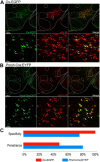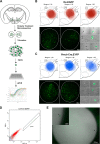Neurochemical Heterogeneity Among Lateral Hypothalamic Hypocretin/Orexin and Melanin-Concentrating Hormone Neurons Identified Through Single-Cell Gene Expression Analysis
- PMID: 28966976
- PMCID: PMC5617207
- DOI: 10.1523/ENEURO.0013-17.2017
Neurochemical Heterogeneity Among Lateral Hypothalamic Hypocretin/Orexin and Melanin-Concentrating Hormone Neurons Identified Through Single-Cell Gene Expression Analysis
Abstract
The lateral hypothalamic area (LHA) lies at the intersection of multiple neural and humoral systems and orchestrates fundamental aspects of behavior. Two neuronal cell types found in the LHA are defined by their expression of hypocretin/orexin (Hcrt/Ox) and melanin-concentrating hormone (MCH) and are both important regulators of arousal, feeding, and metabolism. Conflicting evidence suggests that these cell populations have a more complex signaling repertoire than previously appreciated, particularly in regard to their coexpression of other neuropeptides and the machinery for the synthesis and release of GABA and glutamate. Here, we undertook a single-cell expression profiling approach to decipher the neurochemical phenotype, and heterogeneity therein, of Hcrt/Ox and MCH neurons. In transgenic mouse lines, we used single-cell quantitative polymerase chain reaction (qPCR) to quantify the expression of 48 key genes, which include neuropeptides, fast neurotransmitter components, and other key markers, which revealed unexpected neurochemical diversity. We found that single MCH and Hcrt/Ox neurons express transcripts for multiple neuropeptides and markers of both excitatory and inhibitory fast neurotransmission. Virtually all MCH and approximately half of the Hcrt/Ox neurons sampled express both the machinery for glutamate release and GABA synthesis in the absence of a vesicular GABA release pathway. Furthermore, we found that this profile is characteristic of a subpopulation of LHA glutamatergic neurons but contrasts with a broad population of LHA GABAergic neurons. Identifying the neurochemical diversity of Hcrt/Ox and MCH neurons will further our understanding of how these populations modulate postsynaptic excitability through multiple signaling mechanisms and coordinate diverse behavioral outputs.
Keywords: cotransmission; hypocretin/orexin; lateral hypothalamic area; melanin-concentrating hormone; neuropeptide; neurotransmitter.
Figures









Similar articles
-
Regulation of synaptic efficacy in hypocretin/orexin-containing neurons by melanin concentrating hormone in the lateral hypothalamus.J Neurosci. 2008 Sep 10;28(37):9101-10. doi: 10.1523/JNEUROSCI.1766-08.2008. J Neurosci. 2008. PMID: 18784290 Free PMC article.
-
Optogenetic evidence for inhibitory signaling from orexin to MCH neurons via local microcircuits.J Neurosci. 2015 Apr 8;35(14):5435-41. doi: 10.1523/JNEUROSCI.5269-14.2015. J Neurosci. 2015. PMID: 25855162 Free PMC article.
-
Multi-transcriptional profiling of melanin-concentrating hormone and orexin-containing neurons.Cell Mol Neurobiol. 2005 Dec;25(8):1209-23. doi: 10.1007/s10571-005-8184-8. Cell Mol Neurobiol. 2005. PMID: 16388333 Free PMC article.
-
Hubs and spokes of the lateral hypothalamus: cell types, circuits and behaviour.J Physiol. 2016 Nov 15;594(22):6443-6462. doi: 10.1113/JP271946. Epub 2016 Jul 19. J Physiol. 2016. PMID: 27302606 Free PMC article. Review.
-
Lateral hypothalamus as a sensor-regulator in respiratory and metabolic control.Physiol Behav. 2013 Sep 10;121:117-24. doi: 10.1016/j.physbeh.2013.03.023. Epub 2013 Apr 3. Physiol Behav. 2013. PMID: 23562864 Free PMC article. Review.
Cited by
-
Orexin/Hypocretin and MCH Neurons: Cognitive and Motor Roles Beyond Arousal.Front Neurosci. 2021 Mar 22;15:639313. doi: 10.3389/fnins.2021.639313. eCollection 2021. Front Neurosci. 2021. PMID: 33828450 Free PMC article. Review.
-
Cell type- and pathway-specific synaptic regulation of orexin neurocircuitry.Brain Res. 2020 Mar 15;1731:145974. doi: 10.1016/j.brainres.2018.10.003. Epub 2018 Oct 5. Brain Res. 2020. PMID: 30296428 Free PMC article. Review.
-
Characterization of Hypothalamic MCH Neuron Development in a 3D Differentiation System of Mouse Embryonic Stem Cells.eNeuro. 2022 Apr 26;9(2):ENEURO.0442-21.2022. doi: 10.1523/ENEURO.0442-21.2022. Print 2022 Mar-Apr. eNeuro. 2022. PMID: 35437265 Free PMC article.
-
Ghrelin's orexigenic action in the lateral hypothalamic area involves indirect recruitment of orexin neurons and arcuate nucleus activation.Psychoneuroendocrinology. 2023 Oct;156:106333. doi: 10.1016/j.psyneuen.2023.106333. Epub 2023 Jul 13. Psychoneuroendocrinology. 2023. PMID: 37454647 Free PMC article.
-
Heterogeneity of Hypocretin/Orexin Neurons.Front Neurol Neurosci. 2021;45:61-74. doi: 10.1159/000514964. Epub 2021 May 28. Front Neurol Neurosci. 2021. PMID: 34052814 Free PMC article. Review.
References
Publication types
MeSH terms
Substances
Grants and funding
LinkOut - more resources
Full Text Sources
Other Literature Sources
Molecular Biology Databases
Miscellaneous
